Final report for ONE15-235
Project Information
Through this grant, the Winooski Natural Resources Conservation District (WNRCD) worked to raise the awareness of soil aeration in Vermont through research, education and outreach. Although aeration of hay-land is a well-known conservation practice, its adoption and use is not widespread in Vermont. Furthermore, the link between aeration and phosphorus pollution reduction is poorly understood.
In an effort to raise understanding and build usage of this important best management practice, the WNRCD partnered with Shelburne Farms and Stone Environmental (SE) to continue a third year of an innovative, paired-watershed research project focusing on how water quality may be impacted and improved by soil aeration.
During the 2015 field season, the effects of aeration on nutrient and suspended sediment transport were evaluated on three paired watershed sites (SHE, FER, and SHO) in hay production. After demonstrating strong statistical relationships between paired watersheds during the calibration phase of the study, we have been disappointed to see marginal or non-existent effects of aeration on nutrients concentrations and loads in runoff following aeration (likely explanations for this are outlined in the research section below).
With the help of partnering agencies, WNRCD staff incorporated findings from this study and other regional research into farmer-friendly outreach materials including handouts and displays for public events and farm site visits. Over the course of WNRCD’s work raising awareness and knowledge of aeration, WNRCD received increased interest from farmers requesting information about aerator use and the benefits of aeration. WNRCD will continue to circulate information and resources about the use of aerators and anticipates continued interest in this soil conservation practice.
Introduction:
WNRCD has promoted the use of soil aeration as a conservation practice to reduce soil compaction and agricultural runoff since 2011. Although the practice is well known, there has been a barrier to adopting soil aeration as a widespread practice within the Lake Champlain basin (LCB). In both 2013 and 2014, WNRCD documented at least ten requests by farmers for more information about the use of the aerator on their fields. Farmers requested information about the benefits of using this practice, the aerator’s efficacy on improving water quality, reducing soil compaction, and expressed the desire to participate in on-farm demonstrations and aerator use instruction.
There is a small amount of research documenting reduced nutrient runoff with the use of soil aeration on fields, but the scientific literature is limited (Vliet et al. 2006). There are few long-term regional studies on the effect of soil aeration on agricultural runoff and Stone’s study is a novel effort for the state of Vermont. The ongoing research to monitor water quality on aerated hayfields at three paired watershed study sites in Vermont (Shoreham = SHO, Shelburne=SHE and Ferrisburgh = FER) was designed to provide a critical link in understanding and promoting soil aeration as a conservation practice to reduce phosphorus loading in the LCB.
This research made it possible to provide farmers with current, regional data demonstrating how aeration might impact and improve watershed health and crop productivity.
- Partner with Stone Environmental and Shelburne Farms to support the continuation of data collection and analysis for the paired watershed study monitoring the effects of soil aeration on agricultural runoff
- Develop outreach materials that draw from the research at Shelburne Farms and other regionally relevant studies on soil aeration in partnership with the Vermont Department of Environmental Conservation
- Share high-quality information from research efforts and technical aerator information with the farming community
- Partner with Shelburne Farms to hold demonstration days for farmers on the use of the aerator
- Work with partner farmers and agencies to promote the use of conservation tillage
- Develop outreach display panels and materials for agricultural events based on the findings from Stone’s ongoing research
- Attend at least two agricultural community events to display and discuss research findings and to provide outreach about aerator use
Cooperators
- (Researcher)
- (Researcher)
- (Researcher)
- (Researcher)
Research
Data Collection:
Runoff from the two watersheds in Shelburne were calibrated during the 2012 and 2013 field seasons. A brief description of the monitoring equipment in place and methods used is detailed below (further details can be found in Stone Environmental's QAPP, which was provided as a supporting document at an earlier date):
To capture runoff at each monitoring station, a hydraulic device known as an H-flume was installed. The flume is bolted to a rectangular plywood approach channel. Plywood wingwalls embedded at least 60 cm in the ground were installed to direct runoff into the flume approach channel. The approach channel is mounted to the wingwall such that the opening is nearly flush with the ground. Through the life of the monitoring program, the flume has been kept level through regular adjustments using a system of turnbuckles.
To collect water flow data, an ultrasonic water level sensor (ISCO 2110 Ultrasonic Flow Module) is installed in the flume to continuously measure stage (water level). Level data is converted to flow rate based on the established hydraulic properties of the flume. These data are used for generation of runoff event hydrographs and total event discharge, and in calculation of pollutant export.
To collect water chemistry data, an ISCO 6712 autosampler has been programmed to pump subsamples of runoff water on a flow-proportional basis into bulk (10-L polyethylene) sample containers. Runoff samples are collected through a screened ~1 cm intake line from a mixing trough that receives the H-flume discharge.
Water temperature and conductivity will be measured continuously in the runoff stream using a HOBO® U24-001 Conductivity Data Logger installed in the mixing trough in the runoff channel below the flume.
Data was collected from approximately April 1 –November 30, 2015. The site was visited monthly by Stone staff to perform routine maintenance, download instruments, and restock supplies. After each rain event, runoff samples were collected (by Shelburne Farms staff) and delivered to the Vermont Department of Environmental Conservation laboratory in Burlington. Event composite samples were analyzed for total phosphorus (TP), total dissolved phosphorus (TDP), total nitrogen (TN), total dissolved nitrogen (TDN), chloride (Cl), and total suspended solids (TSS) concentration. Up to 20 runoff events (weather permitting) were monitored during the 2015 field season. Stone will continue to store the runoff data and incorporate it into their existing analyses.
Data Analysis:
Analysis of all field runoff samples was conducted by the VT DEC laboratory, stationed at the University of Vermont. All water samples are analyzed in accordance with the standard methods of the VT DEC Laboratory.
All project data collected was archived in original form (digital downloads, laboratory reports) and organized in databases and Excel spreadsheets by Stone. Transcribed data was checked for errors between original source and files used for reporting and analysis. All statistical analyses will be conducted using JMP statistical software.
Data analysis will continue, per the original study protocols outlined in the QAPP, by the University of Vermont.
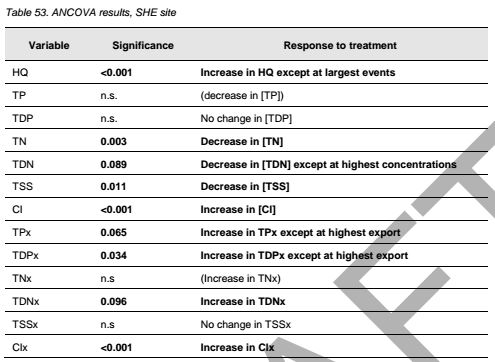
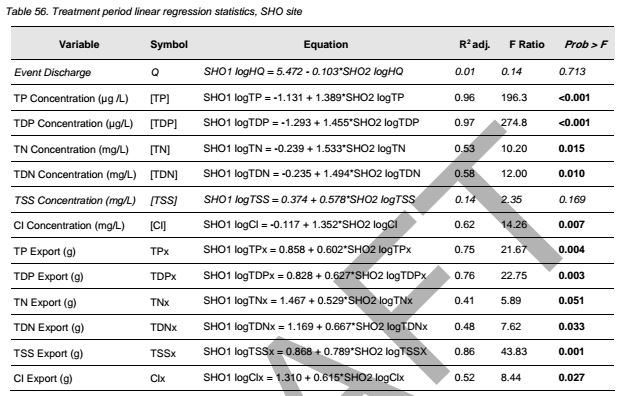
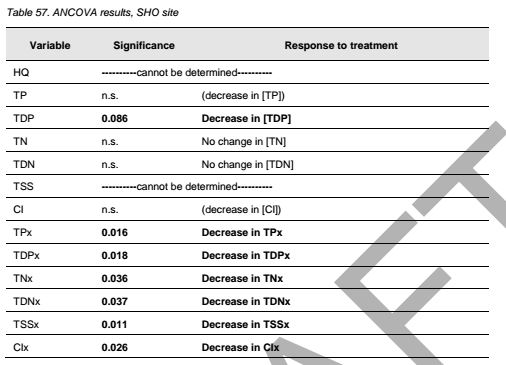
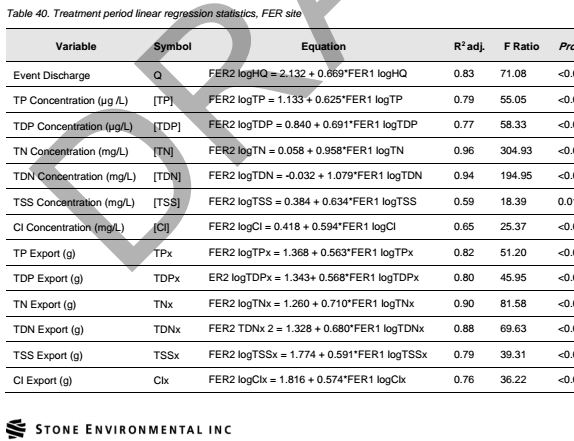
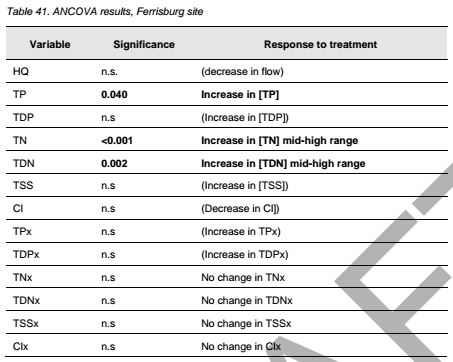
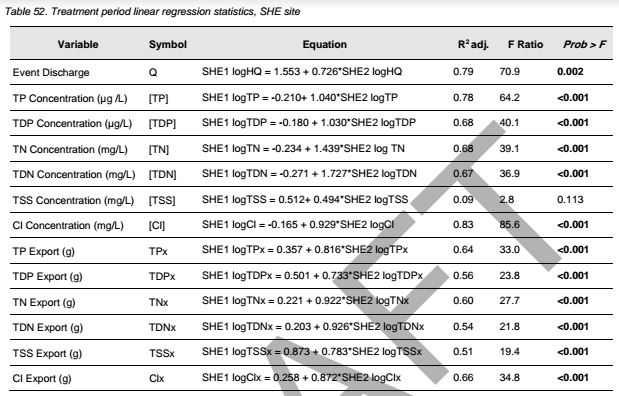
- For FER site, Phosphorus and Total N and Dissolved N export from watershed was greater with the aerated treatment watershed. The assumption is that this must have been because flow was higher in treatment watershed.
- For SHE site, there was a decrease in Total N and Total Dissolved N and Chloride on the aerated fields the Total Phosphorus and Total Dissolved Phosphorus runoff was the same for aeration as for no aeration.
- Finally, aeration at the SHO site showed decreases in most nutrients or no change in some
Taken together, the monitoring data across the paired watersheds in hay production demonstrate the critical effect of the timing of manure application on runoff concentrations of phosphorus and nitrogen. Phosphorus and nitrogen event mean concentrations in runoff following manure application were typically more than an order of magnitude higher than events preceding manure application. Another interesting finding was that the proportion of phosphorus exported from the hay fields in the dissolved form, which is immediately available for plant uptake, was greater than 80 percent on average, and often approached 100 percent.
After demonstrating strong statistical relationships between paired watersheds during the calibration phase of the study, we have been disappointed to see marginal or non-existent effects of aeration on nutrients concentrations and loads in runoff following aeration. There are many likely explanations for the observed weakness of the treatment effects including:
• Practices were poorly implemented or misapplied in some cases
̶ Once the wrong field was aerated (at SHO)
̶ Manure application rates between paired fields were often unequal at the FER and SHE sites.
• Learning curve - it often takes a few years for farmers to get up to speed with a new practice or piece of equipment
• Statistical analyses included data gathered year-round (including some winter events) whereas certain practices, including aeration, should be most effective shortly after installation. We are still considering how best to stratify these data to examine treatment effects over short time windows.
• Confounding environmental conditions
̶ Extended dry periods in the 2014, 2015, and 2016 growing seasons
• Heaved flumes and attendant ponding (significant at SHE) effected total runoff volumes during certain events in late 2015 and early 2016
Thanks to finding from NESARE, the original study and its continuance at the SHE site has provided a wealth of information on runoff event mean concentrations and loads from hay fields in the Lake Champlain Basin. Despite 2016 being a drought year, the additional year of monitoring enabled by NESARE added six paired runoff events, strengthening the long term data set at the SHE site, which now totals over 30 paired events. Furthermore, it allowed time to identify UVM Extension as a willing organization to continue monitoring work at this site, which will allow this valuable dataset to become more and more useful as the years pass.
Education & Outreach Activities and Participation Summary
Participation Summary:
- 20 one-farm site visits providing education about aeration and other conservation practices
- 7 fact sheets and display materials showcasing WNRCD aerator and aeration findings
- 1 on-farm demonstration - "Aerator Demo Day" on Oct 8th, 2015 (29 participants)
- 4 press releases and newsletters published referencing aerator and aeration study
- 1 tour - Aerator Demo Day
- 3 talks about aeration - Aerator Demo Day and at 2, Nutrient Management Plan classes
- 1 workshop - Aerator Demo Day
- Tabled at 3 events: 2016 and 2017 VT Farm Show and 2017 Northeast Organic Farm Association conference, showcasing aeration rental program and aerator fact sheets
- Spoke with over 250 farmers during the grant period at local events, workshops, classes, conferences, and during one-one-one farm site visits about aerator and aeration study
Frequently-Asked-Questions_Aerator Aerator-Rental-Info Aerator-Maintenance Soil-Aeration-factsheet- Aerator-Factsheet-TRIfold Aerator-Mailer Aerator-Sign
Learning Outcomes
Knowledge of conservation practices that are beneficial to water quality and crop production
Project Outcomes
WNRCD has received increased interest from farmers requesting information about aerator use and the benefits of aeration. WNRCD will continue to circulate information and resources about the use of aerators and anticipates continued interested in this soil conservation practice.
Unfortunately, the reduction in nutrients concentrations and runoff loads showed marginal or non-existent effects from aeration, and thus our research question as to whether aeration improves water quality remains unanswered. These are due to a number of likely complications and challenges, which are listed in the research conclusion section above.
The best way to address these concerns is for consultant groups conducting this motoring work to address the concerns listed above, and to continue this monitoring work as these growing data sets become more valuable over time. Fortunately, the UVM Extension (the 1 new working collaboration listed) has agreed to continue this work and will be fully briefed on the challenges and considerations listed.
We still intend to promote the use of aeration to the farming community, as several other regional studies did show runoff load reduction from this practice. These findings were promoted and showcased in outreach materials developed through this grant.